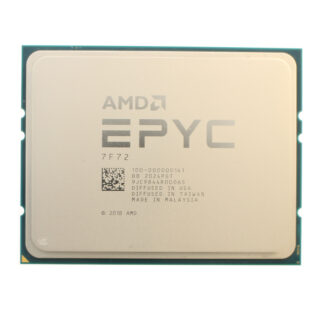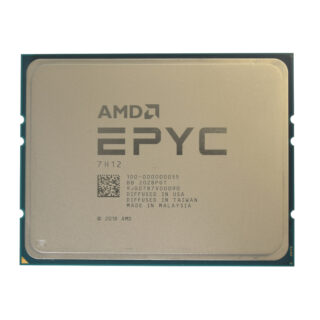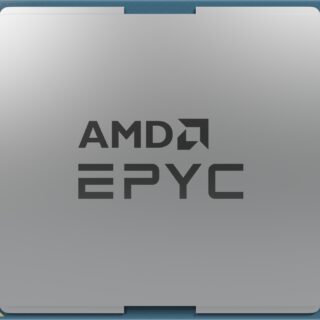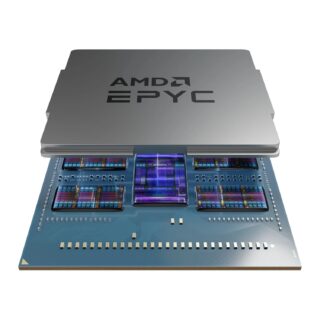Categories
TOP RATED PRODUCTS
-
 AMD EPYC 7663P
$3,139.00
AMD EPYC 7663P
$3,139.00
-
 AMD EPYC 7643P
$2,722.00
AMD EPYC 7643P
$2,722.00
-
 AMD EPYC 7303P
$594.00
AMD EPYC 7303P
$594.00
-
 AMD EPYC 7303
$604.00
AMD EPYC 7303
$604.00
-
 AMD EPYC 7203P
$348.00
AMD EPYC 7203P
$348.00
CLIENT'S TESTOMONIAL

JACK
Vivamus sit amet egestas metus. Interdum et malesuada fames ac ante ipsum primis in faucibus. Interdum et malesuada fames ac ante ipsum primis in faucibus.

ROBIN
Vivamus sit amet egestas metus. Interdum et malesuada fames ac ante ipsum primis in faucibus. Interdum et malesuada fames ac ante ipsum primis in faucibus.
Category: CPU/Processor
CPU/Processor
Showing 49–64 of 127 results
-
AMD Server CPU
AMD EPYC 7F52
$3,350.00Add to cartThe AMD EPYC 7F52 is a server/workstation processor with 16 cores, launched in April 2020. It is part of the EPYC lineup, using the Zen 2 (Rome) architecture with Socket SP3. Thanks to AMD Simultaneous Multithreading (SMT) the core-count is effectively doubled, to 32 threads. To further increase overall system performance, up to two EPYC 7F52 CPUs can link up in a multi-processor (SMP) configuration. EPYC 7F52 has 256 MB of L3 cache and operates at 3.5 GHz by default, but can boost up to 3.9 GHz, depending on the workload. AMD is building the EPYC 7F52 on a 7 nm production process using 3,800 million transistors. The silicon die of the chip is not fabricated at AMD, but at the foundry of TSMC. The multiplier is locked on EPYC 7F52, which limits its overclocking capabilities.
With a TDP of 155 W, the EPYC 7F52 is extremely power hungry, which means you need top-notch cooling. AMD’s processor supports DDR4 memory with an eight-channel interface. The highest officially supported memory speed is 3200 MT/s, but with overclocking (and the right memory modules) you can go even higher. ECC memory is supported, too, which is an important capability for mission-critical systems, to avoid data corruption. For communication with other components in the computer, EPYC 7F52 uses a PCI-Express Gen 4 connection. This processor lacks integrated graphics, you might need a graphics card.
Hardware virtualization is available on the EPYC 7F52, which greatly improves virtual machine performance. Additionally, IOMMU virtualization (PCI passthrough) is supported, so that guest virtual machines may directly use host hardware. Programs using Advanced Vector Extensions (AVX) will run on this processor, boosting performance for calculation-heavy applications. Besides AVX, AMD is including the newer AVX2 standard, too, but not AVX-512. -
AMD Server CPU
AMD EPYC 7F72
$1,360.00Add to cartThe AMD EPYC 7F72 is a server/workstation processor with 24 cores, launched in April 2020. It is part of the EPYC lineup, using the Zen 2 (Rome) architecture with Socket SP3. Thanks to AMD Simultaneous Multithreading (SMT) the core-count is effectively doubled, to 48 threads. To further increase overall system performance, up to two EPYC 7F72 CPUs can work together in a multi-processor (SMP) configuration. EPYC 7F72 has 192 MB of L3 cache and operates at 3.2 GHz by default, but can boost up to 3.7 GHz, depending on the workload. AMD is making the EPYC 7F72 on a 7 nm production node using 3,800 million transistors. The silicon die of the chip is not fabricated at AMD, but at the foundry of TSMC. The multiplier is locked on EPYC 7F72, which limits its overclocking potential.
With a TDP of 240 W, the EPYC 7F72 is extremely power hungry, which means you need top-notch cooling. AMD’s processor supports DDR4 memory with an eight-channel interface. The highest officially supported memory speed is 3200 MT/s, but with overclocking (and the right memory modules) you can go even higher. ECC memory is supported, too, which is an important capability for mission-critical systems, to avoid data corruption. For communication with other components in the system, EPYC 7F72 uses a PCI-Express Gen 4 connection. This processor lacks integrated graphics, you might need a graphics card.
Hardware virtualization is available on the EPYC 7F72, which greatly improves virtual machine performance. Additionally, IOMMU virtualization (PCI passthrough) is supported, so that guest virtual machines may directly use host hardware. Programs using Advanced Vector Extensions (AVX) can run on this processor, boosting performance for calculation-heavy applications. Besides AVX, AMD is including the newer AVX2 standard, too, but not AVX-512. -
AMD Server CPU
AMD EPYC 7H12
$3,687.00Add to cartThe AMD EPYC 7H12 is a server/workstation processor with 64 cores, launched in September 2019. It is part of the EPYC lineup, using the Zen 2 (Rome) architecture with Socket SP3. Thanks to AMD Simultaneous Multithreading (SMT) the core-count is effectively doubled, to 128 threads. To further increase overall system performance, up to two EPYC 7H12 CPUs can work together in a multi-processor (SMP) configuration. EPYC 7H12 has 256 MB of L3 cache and operates at 2.6 GHz by default, but can boost up to 3.3 GHz, depending on the workload. AMD is making the EPYC 7H12 on a 7 nm production node using 3,800 million transistors. The silicon die of the chip is not fabricated at AMD, but at the foundry of TSMC. The multiplier is locked on EPYC 7H12, which limits its overclocking potential.
With a TDP of 280 W, the EPYC 7H12 is extremely power hungry, which means you need top-notch cooling. AMD’s processor supports DDR4 memory with an eight-channel interface. The highest officially supported memory speed is 3200 MT/s, but with overclocking (and the right memory modules) you can go even higher. ECC memory is supported, too, which is an important capability for mission-critical systems, to avoid data corruption. For communication with other components in the computer, EPYC 7H12 uses a PCI-Express Gen 4 connection. This processor lacks integrated graphics, you might need a graphics card.
Hardware virtualization is available on the EPYC 7H12, which greatly improves virtual machine performance. Additionally, IOMMU virtualization (PCI passthrough) is supported, so that guest virtual machines may directly use host hardware. Programs using Advanced Vector Extensions (AVX) can run on this processor, boosting performance for calculation-heavy applications. Besides AVX, AMD is including the newer AVX2 standard, too, but not AVX-512. -
AMD Server CPU
AMD EPYC 8024PN
$525.00Add to cartThe AMD EPYC 8124PN is a server/workstation processor with 16 cores, launched in September 2023. It is part of the EPYC lineup, using the Zen 4c (Siena) architecture with Socket SP6. Thanks to AMD Simultaneous Multithreading (SMT) the core-count is effectively doubled, to 32 threads. EPYC 8124PN has 64 MB of L3 cache and operates at 2000 MHz by default, but can boost up to 3 GHz, depending on the workload. AMD is making the EPYC 8124PN on a 5 nm production node using 17,750 million transistors. The silicon die of the chip is not fabricated at AMD, but at the foundry of TSMC. The multiplier is locked on EPYC 8124PN, which limits its overclocking potential.
With a TDP of 100 W, the EPYC 8124PN consumes a good deal of power, so decent cooling is needed. AMD’s processor supports DDR5 memory with a six-channel interface. The highest officially supported memory speed is 4800 MT/s, but with overclocking (and the right memory modules) you can go even higher. ECC memory is supported, too, which is an important capability for mission-critical systems, to avoid data corruption. For communication with other components in the machine, EPYC 8124PN uses a PCI-Express Gen 5 connection. This processor lacks integrated graphics, you might need a graphics card.
Hardware virtualization is available on the EPYC 8124PN, which greatly improves virtual machine performance. Programs using Advanced Vector Extensions (AVX) can run on this processor, boosting performance for calculation-heavy applications. Besides AVX, AMD has added support for the newer AVX2 and AVX-512 instructions, too. -
AMD Server CPU
AMD EPYC 8124P
$639.00Add to cartThe AMD EPYC 8124P is a server/workstation processor with 16 cores, launched in September 2023. It is part of the EPYC lineup, using the Zen 4c (Siena) architecture with Socket SP6. Thanks to AMD Simultaneous Multithreading (SMT) the core-count is effectively doubled, to 32 threads. EPYC 8124P has 64 MB of L3 cache and operates at 2.45 GHz by default, but can boost up to 3 GHz, depending on the workload. AMD is building the EPYC 8124P on a 5 nm production process using 17,750 million transistors. The silicon die of the chip is not fabricated at AMD, but at the foundry of TSMC. The multiplier is locked on EPYC 8124P, which limits its overclocking capabilities.
With a TDP of 125 W, the EPYC 8124P consumes a lot of power, so good cooling is definitely needed. AMD’s processor supports DDR5 memory with a six-channel interface. The highest officially supported memory speed is 4800 MT/s, but with overclocking (and the right memory modules) you can go even higher. ECC memory is supported, too, which is an important capability for mission-critical systems, to avoid data corruption. For communication with other components in the machine, EPYC 8124P uses a PCI-Express Gen 5 connection. This processor lacks integrated graphics, you might need a graphics card.
Hardware virtualization is available on the EPYC 8124P, which greatly improves virtual machine performance. Programs using Advanced Vector Extensions (AVX) will run on this processor, boosting performance for calculation-heavy applications. Besides AVX, AMD has added support for the newer AVX2 and AVX-512 instructions, too. -
AMD Server CPU
AMD EPYC 8224P
$855.00Add to cartThe AMD EPYC 8224P is a server/workstation processor with 24 cores, launched in September 2023. It is part of the EPYC lineup, using the Zen 4c (Siena) architecture with Socket SP6. Thanks to AMD Simultaneous Multithreading (SMT) the core-count is effectively doubled, to 48 threads. EPYC 8224P has 64 MB of L3 cache and operates at 2.55 GHz by default, but can boost up to 3 GHz, depending on the workload. AMD is making the EPYC 8224P on a 5 nm production node using 17,750 million transistors. The silicon die of the chip is not fabricated at AMD, but at the foundry of TSMC. The multiplier is locked on EPYC 8224P, which limits its overclocking potential.
With a TDP of 160 W, the EPYC 8224P is extremely power hungry, which means you need top-notch cooling. AMD’s processor supports DDR5 memory with a six-channel interface. The highest officially supported memory speed is 4800 MT/s, but with overclocking (and the right memory modules) you can go even higher. ECC memory is supported, too, which is an important capability for mission-critical systems, to avoid data corruption. For communication with other components in the system, EPYC 8224P uses a PCI-Express Gen 5 connection. This processor lacks integrated graphics, you might need a graphics card.
Hardware virtualization is available on the EPYC 8224P, which greatly improves virtual machine performance. Programs using Advanced Vector Extensions (AVX) can run on this processor, boosting performance for calculation-heavy applications. Besides AVX, AMD has added support for the newer AVX2 and AVX-512 instructions, too. -
AMD Server CPU
AMD EPYC 8224PN
$1,015.00Add to cartThe AMD EPYC 8224PN is a server/workstation processor with 24 cores, launched in September 2023. It is part of the EPYC lineup, using the Zen 4c (Siena) architecture with Socket SP6. Thanks to AMD Simultaneous Multithreading (SMT) the core-count is effectively doubled, to 48 threads. EPYC 8224PN has 64 MB of L3 cache and operates at 2000 MHz by default, but can boost up to 3 GHz, depending on the workload. AMD is building the EPYC 8224PN on a 5 nm production process using 17,750 million transistors. The silicon die of the chip is not fabricated at AMD, but at the foundry of TSMC. The multiplier is locked on EPYC 8224PN, which limits its overclocking capabilities.
With a TDP of 120 W, the EPYC 8224PN consumes a lot of power, so good cooling is definitely needed. AMD’s processor supports DDR5 memory with a six-channel interface. The highest officially supported memory speed is 4800 MT/s, but with overclocking (and the right memory modules) you can go even higher. ECC memory is supported, too, which is an important capability for mission-critical systems, to avoid data corruption. For communication with other components in the computer, EPYC 8224PN uses a PCI-Express Gen 5 connection. This processor lacks integrated graphics, you might need a graphics card.
Hardware virtualization is available on the EPYC 8224PN, which greatly improves virtual machine performance. Programs using Advanced Vector Extensions (AVX) will run on this processor, boosting performance for calculation-heavy applications. Besides AVX, AMD has added support for the newer AVX2 and AVX-512 instructions, too. -
AMD Server CPU
AMD EPYC 8324P
$1,895.00Add to cartThe AMD EPYC 8324P is a server/workstation processor with 32 cores, launched in September 2023. It is part of the EPYC lineup, using the Zen 4c (Siena) architecture with Socket SP6. Thanks to AMD Simultaneous Multithreading (SMT) the core-count is effectively doubled, to 64 threads. EPYC 8324P has 128 MB of L3 cache and operates at 2.65 GHz by default, but can boost up to 3 GHz, depending on the workload. AMD is building the EPYC 8324P on a 5 nm production process using 35,500 million transistors. The silicon die of the chip is not fabricated at AMD, but at the foundry of TSMC. The multiplier is locked on EPYC 8324P, which limits its overclocking capabilities.
With a TDP of 180 W, the EPYC 8324P is extremely power hungry, which means you need top-notch cooling. AMD’s processor supports DDR5 memory with a six-channel interface. The highest officially supported memory speed is 4800 MT/s, but with overclocking (and the right memory modules) you can go even higher. ECC memory is supported, too, which is an important capability for mission-critical systems, to avoid data corruption. For communication with other components in the computer, EPYC 8324P uses a PCI-Express Gen 5 connection. This processor lacks integrated graphics, you might need a graphics card.
Hardware virtualization is available on the EPYC 8324P, which greatly improves virtual machine performance. Programs using Advanced Vector Extensions (AVX) will run on this processor, boosting performance for calculation-heavy applications. Besides AVX, AMD has added support for the newer AVX2 and AVX-512 instructions, too. -
AMD Server CPU
AMD EPYC 8324PN
$2,125.00Add to cartThe AMD EPYC 8324PN is a server/workstation processor with 32 cores, launched in September 2023. It is part of the EPYC lineup, using the Zen 4c (Siena) architecture with Socket SP6. Thanks to AMD Simultaneous Multithreading (SMT) the core-count is effectively doubled, to 64 threads. EPYC 8324PN has 128 MB of L3 cache and operates at 2.05 GHz by default, but can boost up to 3 GHz, depending on the workload. AMD is making the EPYC 8324PN on a 5 nm production node using 35,500 million transistors. The silicon die of the chip is not fabricated at AMD, but at the foundry of TSMC. The multiplier is locked on EPYC 8324PN, which limits its overclocking potential.With a TDP of 130 W, the EPYC 8324PN consumes a lot of power, so good cooling is definitely needed. AMD’s processor supports DDR5 memory with a six-channel interface. The highest officially supported memory speed is 4800 MT/s, but with overclocking (and the right memory modules) you can go even higher. ECC memory is supported, too, which is an important capability for mission-critical systems, to avoid data corruption. For communication with other components in the system, EPYC 8324PN uses a PCI-Express Gen 5 connection. This processor lacks integrated graphics, you might need a graphics card.Hardware virtualization is available on the EPYC 8324PN, which greatly improves virtual machine performance. Programs using Advanced Vector Extensions (AVX) can run on this processor, boosting performance for calculation-heavy applications. Besides AVX, AMD has added support for the newer AVX2 and AVX-512 instructions, too.
-
AMD Server CPU
AMD EPYC 8434P
$2,700.00Add to cartThe AMD EPYC 8434P is a server/workstation processor with 48 cores, launched in September 2023. It is part of the EPYC lineup, using the Zen 4c (Siena) architecture with Socket SP6. Thanks to AMD Simultaneous Multithreading (SMT) the core-count is effectively doubled, to 96 threads. EPYC 8434P has 128 MB of L3 cache and operates at 2.5 GHz by default, but can boost up to 3.1 GHz, depending on the workload. AMD is making the EPYC 8434P on a 5 nm production node using 35,500 million transistors. The silicon die of the chip is not fabricated at AMD, but at the foundry of TSMC. The multiplier is locked on EPYC 8434P, which limits its overclocking potential.
With a TDP of 200 W, the EPYC 8434P is extremely power hungry, which means you need top-notch cooling. AMD’s processor supports DDR5 memory with a six-channel interface. The highest officially supported memory speed is 4800 MT/s, but with overclocking (and the right memory modules) you can go even higher. ECC memory is supported, too, which is an important capability for mission-critical systems, to avoid data corruption. For communication with other components in the machine, EPYC 8434P uses a PCI-Express Gen 5 connection. This processor lacks integrated graphics, you might need a graphics card.
Hardware virtualization is available on the EPYC 8434P, which greatly improves virtual machine performance. Programs using Advanced Vector Extensions (AVX) can run on this processor, boosting performance for calculation-heavy applications. Besides AVX, AMD has added support for the newer AVX2 and AVX-512 instructions, too. -
AMD Server CPU
AMD EPYC 8434PN
$3,150.00Add to cartThe AMD EPYC 8434PN is a server/workstation processor with 48 cores, launched in September 2023. It is part of the EPYC lineup, using the Zen 4c (Siena) architecture with Socket SP6. Thanks to AMD Simultaneous Multithreading (SMT) the core-count is effectively doubled, to 96 threads. EPYC 8434PN has 128 MB of L3 cache and operates at 2000 MHz by default, but can boost up to 3 GHz, depending on the workload. AMD is building the EPYC 8434PN on a 5 nm production process using 35,500 million transistors. The silicon die of the chip is not fabricated at AMD, but at the foundry of TSMC. The multiplier is locked on EPYC 8434PN, which limits its overclocking capabilities.
With a TDP of 155 W, the EPYC 8434PN is extremely power hungry, which means you need top-notch cooling. AMD’s processor supports DDR5 memory with a six-channel interface. The highest officially supported memory speed is 4800 MT/s, but with overclocking (and the right memory modules) you can go even higher. ECC memory is supported, too, which is an important capability for mission-critical systems, to avoid data corruption. For communication with other components in the machine, EPYC 8434PN uses a PCI-Express Gen 5 connection. This processor lacks integrated graphics, you might need a graphics card.
Hardware virtualization is available on the EPYC 8434PN, which greatly improves virtual machine performance. Programs using Advanced Vector Extensions (AVX) will run on this processor, boosting performance for calculation-heavy applications. Besides AVX, AMD has added support for the newer AVX2 and AVX-512 instructions, too. -
AMD Server CPU
AMD EPYC 8534P
$4,950.00Add to cartThe AMD EPYC 8534P is a server/workstation processor with 64 cores, launched in September 2023, at an MSRP of $4950. It is part of the EPYC lineup, using the Zen 4c (Siena) architecture with Socket SP6. Thanks to AMD Simultaneous Multithreading (SMT) the core-count is effectively doubled, to 128 threads. EPYC 8534P has 128 MB of L3 cache and operates at 2.3 GHz by default, but can boost up to 3.1 GHz, depending on the workload. AMD is making the EPYC 8534P on a 5 nm production node using 35,500 million transistors. The silicon die of the chip is not fabricated at AMD, but at the foundry of TSMC. The multiplier is locked on EPYC 8534P, which limits its overclocking potential.
With a TDP of 200 W, the EPYC 8534P is extremely power hungry, which means you need top-notch cooling. AMD’s processor supports DDR5 memory with a six-channel interface. The highest officially supported memory speed is 4800 MT/s, but with overclocking (and the right memory modules) you can go even higher. ECC memory is supported, too, which is an important capability for mission-critical systems, to avoid data corruption. For communication with other components in the computer, EPYC 8534P uses a PCI-Express Gen 5 connection. This processor lacks integrated graphics, you might need a graphics card.
Hardware virtualization is available on the EPYC 8534P, which greatly improves virtual machine performance. Programs using Advanced Vector Extensions (AVX) can run on this processor, boosting performance for calculation-heavy applications. Besides AVX, AMD has added support for the newer AVX2 and AVX-512 instructions, too. -
AMD Server CPU
AMD EPYC 8534PN
$5,450.00Add to cartThe AMD EPYC 8534PN is a server/workstation processor with 64 cores, launched in September 2023, at an MSRP of $5450. It is part of the EPYC lineup, using the Zen 4c (Siena) architecture with Socket SP6. Thanks to AMD Simultaneous Multithreading (SMT) the core-count is effectively doubled, to 128 threads. EPYC 8534PN has 128 MB of L3 cache and operates at 2000 MHz by default, but can boost up to 3.1 GHz, depending on the workload. AMD is building the EPYC 8534PN on a 5 nm production process using 35,500 million transistors. The silicon die of the chip is not fabricated at AMD, but at the foundry of TSMC. The multiplier is locked on EPYC 8534PN, which limits its overclocking capabilities.
With a TDP of 175 W, the EPYC 8534PN is extremely power hungry, which means you need top-notch cooling. AMD’s processor supports DDR5 memory with a six-channel interface. The highest officially supported memory speed is 4800 MT/s, but with overclocking (and the right memory modules) you can go even higher. ECC memory is supported, too, which is an important capability for mission-critical systems, to avoid data corruption. For communication with other components in the system, EPYC 8534PN uses a PCI-Express Gen 5 connection. This processor lacks integrated graphics, you might need a graphics card.
Hardware virtualization is available on the EPYC 8534PN, which greatly improves virtual machine performance. Programs using Advanced Vector Extensions (AVX) will run on this processor, boosting performance for calculation-heavy applications. Besides AVX, AMD has added support for the newer AVX2 and AVX-512 instructions, too. -
AMD Server CPU
AMD EPYC 9124
$1,083.00Add to cartThe AMD EPYC 9124 is a server/workstation processor with 16 cores, launched in November 2022, at an MSRP of $1083. It is part of the EPYC lineup, using the Zen 4 (Genoa) architecture with Socket SP5. Thanks to AMD Simultaneous Multithreading (SMT) the core-count is effectively doubled, to 32 threads. To further increase overall system performance, up to two EPYC 9124 CPUs can link up in a multi-processor (SMP) configuration. EPYC 9124 has 64 MB of L3 cache and operates at 3 GHz by default, but can boost up to 3.7 GHz, depending on the workload. AMD is building the EPYC 9124 on a 5 nm production process using 26,280 million transistors. The silicon die of the chip is not fabricated at AMD, but at the foundry of TSMC. The multiplier is locked on EPYC 9124, which limits its overclocking capabilities.
With a TDP of 200 W, the EPYC 9124 is extremely power hungry, which means you need top-notch cooling. AMD’s processor supports DDR5 memory with a twelve-channel interface. The highest officially supported memory speed is 4800 MT/s, but with overclocking (and the right memory modules) you can go even higher. ECC memory is supported, too, which is an important capability for mission-critical systems, to avoid data corruption. For communication with other components in the system, EPYC 9124 uses a PCI-Express Gen 5 connection. This processor lacks integrated graphics, you might need a graphics card.
Hardware virtualization is available on the EPYC 9124, which greatly improves virtual machine performance. Programs using Advanced Vector Extensions (AVX) will run on this processor, boosting performance for calculation-heavy applications. Besides AVX, AMD has added support for the newer AVX2 and AVX-512 instructions, too. -
AMD Server CPU
AMD EPYC 9174F
$3,850.00Add to cartThe AMD EPYC 9174F is a server/workstation processor with 16 cores, launched in November 2022, at an MSRP of $3850. It is part of the EPYC lineup, using the Zen 4 (Genoa) architecture with Socket SP5. Thanks to AMD Simultaneous Multithreading (SMT) the core-count is effectively doubled, to 32 threads. To further increase overall system performance, up to two EPYC 9174F CPUs can work together in a multi-processor (SMP) configuration. EPYC 9174F has 256 MB of L3 cache and operates at 4.1 GHz by default, but can boost up to 4.4 GHz, depending on the workload. AMD is making the EPYC 9174F on a 5 nm production node using 52,560 million transistors. The silicon die of the chip is not fabricated at AMD, but at the foundry of TSMC. The multiplier is locked on EPYC 9174F, which limits its overclocking potential.
With a TDP of 320 W, the EPYC 9174F is extremely power hungry, which means you need top-notch cooling. AMD’s processor supports DDR5 memory with a twelve-channel interface. The highest officially supported memory speed is 4800 MT/s, but with overclocking (and the right memory modules) you can go even higher. ECC memory is supported, too, which is an important capability for mission-critical systems, to avoid data corruption. For communication with other components in the machine, EPYC 9174F uses a PCI-Express Gen 5 connection. This processor lacks integrated graphics, you might need a graphics card.
Hardware virtualization is available on the EPYC 9174F, which greatly improves virtual machine performance. Programs using Advanced Vector Extensions (AVX) can run on this processor, boosting performance for calculation-heavy applications. Besides AVX, AMD has added support for the newer AVX2 and AVX-512 instructions, too.
ABOUT ME
FEATURED PRODUCTS
AD WIDGET

FROM THE BLOG
vel mollis massa urna sollicitudin mi. Nullam nulla nisi, accumsan eu finibus eu, vestibulum eget dui. Lorem ipsum dolor sit amet, consectetur adipiscing elit. Aenean feugiat dolor ligula, ac dictum libero sodales at. Pellentesque vulputate eros eu mattis aliquet. Curabitur euismod neque sit amet mauris condimentum, nec faucibus ex ultricies. Aenean finibus lacus vel tortor
Dharetra lorem, sed pulvinar purus. Nam eleifend euismod faucibus. Sed pharetra cursus convallis. Cras mollis nulla tristique risus gravida, in posuere ligula pretium. Nulla congue ex vitae erat egestas tincidunt. Mauris a orci quis urna feugiat sollicitudin. Maecenas finibus cursus neque, a molestie leo viverra sed. Curabitur id odio sed tellus fringilla tristique. Etiam egestas
Vivamus non fermentum nunc. Nulla hendrerit vestibulum condimentum. Vestibulum ante ipsum primis in faucibus orci luctus et ultrices posuere cubilia curae; Cras eget lacinia nulla. Donec vitae auctor quam. Donec nibh lacus, scelerisque sit amet semper sit amet, consequat in nisi. Maecenas blandit porttitor diam, ut dignissim massa iaculis tincidunt. Maecenas sapien erat, gravida id







